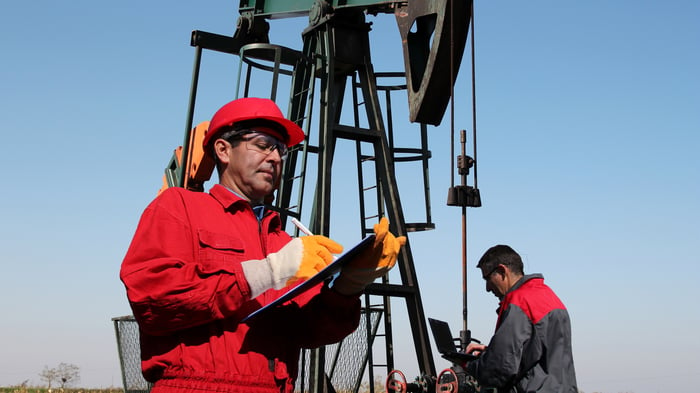The growth in U.S. oil and natural gas production has upended the world's supply-demand balance, and not in a good way. Oil prices have lingered in a relatively low range that's made it difficult for even the largest energy companies to make money. That has a tap-on effect for oil services companies like Helmerich & Payne (HP -0.12%). However, despite the industrywide weakness, this particular company is worth examining more closely.
Like a rock
Oil and natural gas have always been highly cyclical. As commodities, they are prone to boom-and-bust cycles, with lofty prices leading to overexpansion and low prices squashing companies that took on too much leverage during the salad days. That's especially true in the energy services niche of the industry, a group of companies that provide drills and drilling services, among other things, for the energy sector.

Image source: Getty Images.
There's really only one way to prepare for the wild swings, and that's to maintain a strong balance sheet throughout the entire cycle. This is the path that Helmerich & Payne has taken. Its debt-to-equity ratio is just 0.10. That's a minuscule amount of leverage for any industry and roughly half the level of its next closest peer. It has the financial strength to keep chugging along no matter what's happening in the broader industry.
Today, Helmerich & Payne's largest market is the onshore U.S. drilling space. Roughly 90% of the drilling rigs it owns operate in this market. As the fracking drilling method started to take hold, this was a region seeing rapid growth in demand. Energy companies piled in, and energy services companies came along for the ride. But as U.S. oil and natural gas output exploded, and the United States became one of the world's largest producers of these fuels, the historical balance in energy markets broke down. Oil and gas prices plummeted and have remained relatively weak for years. To be fair, there are still ups and downs in the highly volatile sector, but there hasn't been a sustained advance that would lead to a material demand spike for energy services firms.
In fact, some companies have chosen to pull back in the U.S. onshore space because of slowing demand for energy services in the region. For example, industry giant Schlumberger (SLB -0.48%), in its fourth-quarter 2019 earnings release, noted:
In North America, we are continuing to scale-to-fit our organization and portfolio by repurposing or exiting underperforming business units, focusing on asset-light operations, and expanding our technology access business models. In alignment with our stated strategy, we are cautiously optimistic that the high-grading of our portfolio will promote margin expansion and the improvement of returns in the North America land market. It has also led to the closing of a significant number of facilities and, unfortunately, workforce reductions.
In other words, it's shutting operations down in the United States. As companies in the sector are forced to make similar decisions, there's an opportunity for players like Helmerich & Payne.
Simply the best
Sporting a rock-solid balance sheet, Helmerich & Payne is financially ready for the industry's ups and downs. However, that's not the only way it prepares itself for battle within this cyclical industry. It also works aggressively to ensure it's offering customers the most desirable products and services. Recently that has meant having a large portfolio of "super spec" alternating-current (AC) rigs. These drilling units are more efficient and often can move themselves from drill site to drill site.
Nearly 80% of Helmerich & Payne's rigs fall into the super-spec category. And nearly 80% of those rigs are currently working in the field. That's an important metric, because of the company's remaining rigs, only 15% are under contract. There's a clear preference for the most advanced rigs. Which leads to another fun fact: Helmerich & Payne has a roughly 23% market share in the United States, but its share within the super-spec subgroup is 37%.
HP Financial Debt to Equity (Quarterly) data by YCharts.
This has been an ongoing trend, with the newer super-spec rigs displacing older technologies for a number of years now. And it's part of the reason why onshore U.S. drilling has become increasingly more efficient, which helps profitability for the customers of drilling services companies. Since oil prices started falling in mid-2014, Helmerich & Payne has gained more market share than any of its closest peers in the onshore U.S. market. In October 2014, the company had a 15% share and has picked up 8 percentage points since. That's a huge increase and easily bests the results of Helmerich & Payne's peers.
Nothing new here
Obviously, there's more to understand about onshore U.S. drilling than just these facts. And Helmerich & Payne's business is shifting and changing just like its peers, as it looks to deal with a difficult market. However, its rock-solid balance sheet, industry-leading onshore drill fleet, and success picking up market share should help it survive and thrive in any oil market. It's tough today in the energy sector, but that won't change the underpinnings at Helmerich & Payne -- it's going to keep doing what it has always done. If you are one of those intrepid investors looking at this out-of-favor sector for bargains, this is one stock you need to consider.






